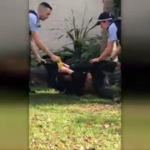Critical Incident Investigation to be Launched into Pepper Spray Death

A critical incident investigation has been launched by the NSW Police Force after the death of a man who was pepper sprayed during his arrest on Sydney’s M5 motorway.
Police were pursuing the man after reports that he had been “running in and out of traffic” on one of Sydney’s busiest motorways.
According to reports, Police had been attempting to arrest the man after reports he was walking in the middle of a major road. When Police arrived, the man was near the Moorebank Avenue off-ramp, and when they attempted to arrest him, police allege that a struggle ensued.
New South Wales Assistant Police Commissioner, Stuart Smith, told the media in a statement:
“He [the deceased] was given directions and was non-responsive to those and a physical altercation occurred (between the man and police)”.
“At some stage they ended up on the roadway, where OC spray was deployed without impact. The OC spray was deployed by one officer.
“Following that, a violent confrontation with the male resulted in him being handcuffed.”
A short time after being handcuffed the man lost consciousness and was taken to Liverpool hospital, but could not be revived.
Critical Incident Investigation
The critical incident investigation will be conducted by the NSW Crime Command’s Homicide Squad – an internal team within the NSW Police Force.
Under the law, police are required to launch a critical incident investigation when a civilian is seriously injured or dies during circumstances which involve police, such as during a police pursuit, an arrest, or while in police custody.
The purpose and responsibilities of a critical incident investigation are outlined in the Law Enforcement Conduct Commission Act 2016 (NSW).
The Act gives the power to the Regional Police Commander to set out the specific objectives of each critical incident investigation.
Section 113 of the Act requires the Commissioner of Police to ensure that the actions of officers in the lead up to and during a critical incident are fully and properly investigated, and that reports are provided to relevant authorities thereafter.
The Commissioner is to consider, in light of the reports, any need for changes to relevant policies, practices and procedures; and any systemic, safety or procedural issues arising from the incident and actions of police officers.
A critical incident investigation examines:
- the lawfulness and reasonableness of their actions
- the extent to which they complied with relevant legislation and policies, practices and procedures
- any complaint about their conduct that has been referred to the senior critical incident investigator; and
- any evidence of officer misconduct.
Findings of critical incident investigations are reviewed by the Law Enforcement Conduct Commission (LECC) – the police oversight body in New South Wales.
However, the watchdog has consistently labelled as ineffective due to the fact it is chronically under-resourced- only investigating around 2% of complaints that come its way – and having no power to discipline let alone independently prosecute police officers.
This leads to a situation where police are essentially policing themselves and there have been calls over many years for an adequately resourced, independent police watchdog with the power to discipline and prosecute officers, rather than just make recommendations in that regard.
Armed against a predominantly unarmed population
In New South Wales all police officers are armed with firearms – they have been since the 1980s.
They also carry tasers which were introduced around 2002, as an “effective tool” for managing violent situations without police having to use firearms.
However, this does not mean that tasers are not dangerous. People have died from being tasered.
Use of OC ‘Pepper Spray’ by NSW Police
In New South Wales, only Police officers trained in the use of Oleoresin Capsicum (OC Spray), otherwise known as ‘pepper spray’ can use OC spray. OS Spray is an oily resin which comes from processing and distilling certain ‘hot’ peppers such as cayenne.
According to the publicly available version of the 2019 NSW Police Force Training Manual for OC Defensive Spray, Police may use the spray for:
- protection of human life,
- for controlling people, where violent resistance or confrontation occurs (or is likely to occur),
- protection against animals.
The manual OC spray as a non-violent weapon, although the effects of pepper spray include:
- Temporary blindness – if contact with the eyes
- Coughing and / or wheezing
- Shortness of breath or an inability to breathe properly
- Burning sensation in the throat
- Chest pain
- Gagging
- A runny nose and watery eyes
- Dizziness
- Rashes and blisters, or discoloration of the skin
- In some cases it can cause loss of consciousness.
The manual also states that it has “no long-lasting or hazardous effects on the human body”. On top of that, police have a “duty of care” over anyone they spray with it.
Three recent deaths from OC Spray
A man also recently died in Victoria after being pepper sprayed by Police and there is a critical incident investigation currently underway within VicPol as well.
A man also died earlier this year in Central Western NSW, after being pepper sprayed by Police.
According to medical experts, while deaths from pepper spray are rare, some research has linked deaths and adverse reactions to the spray to people with asthma or other lung conditions.
With three deaths occurring within months of each other, two within days of each other, questions need to be asked about the spray itself – whether or not it is a ‘bad batch’. But as a community we also need to be asking more questions about the use of pepper spray and why it is considered ‘non-violent’ when it has such a long list of potential effects.
With increasing reports of police brutality – not just in New South Wales, but across the nation – and an increase in the number of injuries and deaths during arrest in recent years, we also need to continue to question police policies involving the use of weapons, clarification around what constitutes ‘reasonable force’ and arrest – which is intended as a measure of last resort – and demand more transparency and accountability around policies and procedures, and how these are managed and enforced.
While police often defend the use of weapons, saying that they are involved in many potentially violent and uncertain, unpredictable situations, and that they often have to make ‘split second decisions,’ when a person dies or is seriously injured during arrest, it leads us all to feel increasingly uncomfortable and weakens our trust in police.
After all, most of us have the expectation that if we were in trouble, we would want to be able to rely on police to get us to safety, not harm us in the process.







